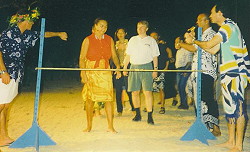
In the heaven there are also angels. I guess the eyes of the first discovers of Tahiti almost popped out when they observed the beautiful girls on the Tahitian islands for the first time. It was an encounter with a new world. Out from the paradise beautiful creatures emerged and they took good hand of their guests. Love was in the air!
In my imagination I could see Tahiti with it's lush green hills and almost naked pretty girls on the beach. I visited Tahiti in July 1998. From the first step I was greeted by beautiful girls with decorated with flowers at the airport in Papeete. It confirmed my impression from legends and movies: Tahitian girls are among the most beautiful girls in the world. The beauty queens at Tahiti can compare with the worlds prettiest girls coming from Finland - Soumi, Norway, Sweden, Iceland, Brazil, Venezuela, Argentina and Colombia.
The Tahiti islands are sprinkled over 5 million sq. km. of ocean in the South Pacific and consists of five 5 island groups, or archipelagos. In land area it has the same size as Europe.
Tahiti, once known as Otaheite, is the largest island of the chain of over 115 isles in the area, known wholly as French Polynesia. Captain James Cook who visited the islands in the mid-1770s noted the romance of the island of Tahiti.
If you are in the capital of Papeete during the Heiva Festival in July, youll truly be in for a treat as the indigenous culture is celebrated.
First contact
In the sixteenth century, Magellen, then later Mendana, reached the archipelagos of the Tuamotu and the Marquesas.
However, it is the Englishman Samuel Wallis who remains renowned for the European discovery of Tahiti in 1767.
The following year, the Frenchman Antoine de Bougainville baptised the island "the new Cythera".
One year later, the Englishman James Cook landed on Tahiti and took possession of the Society Islands. In 1766, the Royal Society hired him to travel to the Pacific Ocean to observe and record the transit of Venus across the Sun. James Cook sailed from England in 1768, rounded Cape Horn and continued westward across the Pacific to arrive at Tahiti on 13 April in 1769, where the observations were to be made.
The transit was scheduled to occur on 3 June, and in the meantime he commissioned the building of a small fort and observatory. I just wonder what captain Cook and his crew observed most of the time on the Tahitian islands; the stars in the sky or the beauty queens on shores? What was most interesting?
Stein Morten Lund, February 2007
